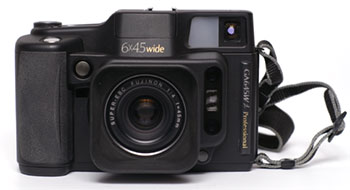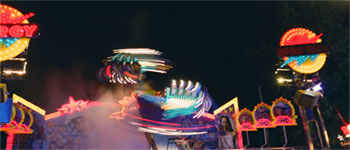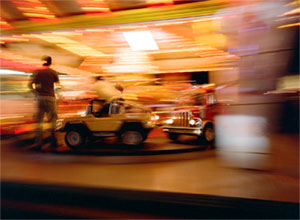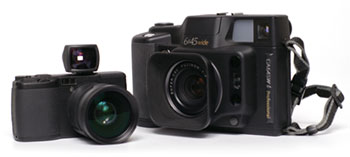
First, a thousand discussions on hundreds of photography web forums suggests that film is not dead. Finger painting didn’t die when brushes were invented. Painting with brushes didn’t stop when the large format camera became available. Large format photography is still in fashion, despite the high-quality 35 mm options. And despite the rise of digital photography, film is still on of my preferred medium for capturing images.
Debating film vs. digital is worse than debating assisted suicide, abortion rights, the war in Iraq, or Israel vs. Hezbolla – because the film vs. digital debate is by definition a colossal waste of time. Use what works for you. What I know is that I get kick-ass photos with film, Fuji Provia is my friend, I like wide angle, I like medium format – and that was enough of a reason to drop 700 USD on a used Fuji GA645wi.

The GA645wi is built with and embodies that age old simplicity design aura, that so many companies ignore. A camera is a light box. Modern ones include automatic shutters and exposure meters, add a bright viewfinder, and not much else matters. The compact Fuji medium format cameras are unique in the camera world, and will for sure never be made again. For travel and mountaineering considerations, the list of equivalent cameras to the Fuji GA645wi is about zero.
It was built to pro standards, is still serviced by Fuji, and produces excellent results. When paired with pro film like Provia, Velvia, Fuji, Kodak, etc., the resulting images are vibrant, sharp, and unlike anything you could get with a comparably priced digital.
45 mm on 6×4.5 is rather unique. Since the lens retracts into the body, you can take the GA645 into many situations, but retain the quality expected of a much larger camera. Much like the GA645 (60 mm lens), there’s program, shutter, and aperture priority shooting modes. Manual focus is possible, but is mainly used only if photographing sunsets that fool the autofocus. The “i” version has two shutter releases, one for portrait, one for landscape orientation.? There’s a built in flash and it will take 120 or 220 film. The autofocus is good, but it’s best when used with static objects. The metering is dead on, it’s designed well and delivers results.

Few things suck more than not being able to capture the image you want after hiking into the Alps or flying across unknown seas. The reason I bought the GA645w is the lens. At 45 mm, the EBC Fujion has an angle of view close to 24 mm on a 35 mm camera body. This is my ideal focal length for land and cityscape shooting. Not so wide that details or subjects are lost, not so telephoto that you can’t fit the whole subject into the viewfinder.
To envision the GA645w, think of a Ricoh GRD or the unreleased Sigma DP1 and stick a syringe of growth hormones into your imagination. A high quality lens paired with a large image capture area. When you buy a Fuji rangefinder, you’re buying a lens with a minimalist, highly engineered body.
The ardent digital defender might say,
“Well, you need to know how to process your photos, with film the lab does all the work, you just don’t know what you’re doing. If you did, you’d shoot digital with RAW.”

This might be partially true. But what I know is that I capture a lot of detail and a large dynamic range with film. It’s a cool look that has over a hundred years of design and development behind it. It just looks good, I know this from experience. Photographing the Swiss Alps or the streets of Europe is awesome with film. Fewer highlights get blown out, and I have more detail in the shadows. I still like film, love digital, and love a wide angle lens, which is also why I’m taking the Fuji GA645wi along on my three month trip to Tokyo, as well as my Ricoh GRD.
I’ve taken some quick shots in Zurich and just love shooting with the GA645wi. The body is rugged and the viewfinder is just an awesome and bright, the way a camera should be. If you’re looking for a compact high quality camera, I recommend seeking one out.

Thanks for imparting solid unbiased knowledge. Looks like your living life!
Dean
You would make Galen Rowell proud. Kudos to you!
Ahhh, to make Galen Rowell proud – thank you, the images from Galen and Barbara are amazing.
Thanks for the write-up. I had been thinking of this camera and the GA645 and I guess I will go for the wide one… suits me :). Looking forward to see more write-up from you. Thanks again.
i own to of these beauties an they never fail to deliver – great write up. on difficult thing is that its a range funder – so if you want to take portraits with the W, you have to watch out bcause the difference between the viewfinder and lense becomes an issue – but for cityscapes and such – nothing beats it.
Anyone wondering about shooting film should read this.
Anyone wondering about shooting 120 should read this twice.
Anyone wondering about shooting with a GA645W should purchase one and just let your imagination run wild (well not too wild now if your pockets aren't deep enough)…
Thanks for a well balanced intro to the camera. Bravo.
Simply unusually well put. Congratulations! (I own a GA645 myself)
Thank you for your great review, Mark !
I second that.
I have a GA645 with the 60mm f/4 for about 1,5 years. I really love it for travel and hiking.
A few days ago I bought another one – a GA645wi with the 45mm f/4 to shoot wider.
One may argue about the `slow´ Fujinon f/4 lenses – I don’t mind about it.
Using Portra 400 or Fuji Pro 400H in bright sunlight, I often need ND grad filters
(0.3 or 0.6 / +1 or +2), because the fastest shutter speed is 1/400 sec..
Autofocus and exposure metering is dead on – negatives are crispy and sharp.
A recommendation for those who love (120) film !